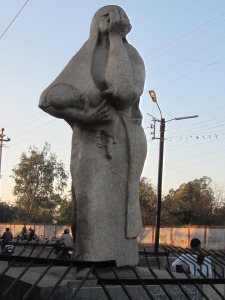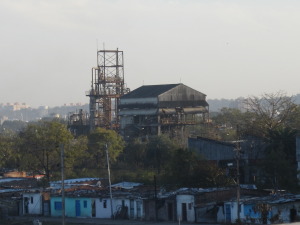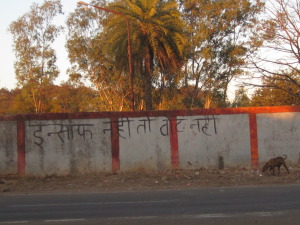Almost 27 years ago, 42 tons of the poisonous methyl isocyanate gas escaped from the American pesticide factory Union Carbide in Bhopal. It killed about 4,00 people in the first few days, and eventually left over 14,000 dead. It has been called the world’s worst industrial disaster, and residents say that even today, more than 100,000 people continue to suffer from chronic illnesses tied to the incident, including cancer, birth disorders, tuberculosis, deression, poor eyesight, and gynecological problems. Rama Lakshmi. (2011) “The Morality of Memory”
Burned out shell of Union Carbide pesticide factory in Bhopal. Gretchen Jennings. January 2014
Museum colleagues around the world who are working to preserve and display difficult histories should be both encouraged and forewarned. The good news is that a new museum commemorating the Bhopal tragedy opened on December 2, 2014, the 30th anniversary of the disaster. The cautionary tale is that the efforts to open this small site took four very challenging years. A government sponsored memorial is still in the planning, but its progress is hampered by the continuing toxicity of the physical site and by persistent sensitive political and social issues. According to the above quoted article by Rama Lakshmi (one of the curators of the recently opened museum) many of the survivors groups in existence since the event have opposed the concept of the government museum, believing that official lack of pursuit of full reparations from Union Carbide and its successor Dow Chemical makes the government complicit, undermining its right to create a memorial.
The survivor groups have worked with Lakshmi and other museum professionals to design and create their own memorial museum, filled with posters, photographs, and heart-wrenching artifacts–a small victim’s dress; a stopped pocket watch–donated by the families of victims and survivors. In the photos posted on the Bhopal Museum Trusts’s Facebook page you can see that the immediacy and vividness envisioned by the creators for the exhibitions have been achieved in the small but well designed galleries.
The museum is located in a neighborhood building near the site. One of the best articles about its opening is here, “Museum of Memories” by V.S. Shaini. As Rama Lakshmi says in this account, this is the first museum in India focusing on a contentious issue that is in living memory, and it should be a model for other efforts in India. I add that it can be a model for efforts to document and commemorate difficult histories everywhere. Rama is both a friend and colleague, and I know from our personal communications that the Bhopal museum team has been both persistent and flexible, abandoning original plans to tour a small exhibition in a bus for several years and yet somehow powering through to get this site opened on time and with compelling design and displays.

1985 sculpture by Holocaust survivor Ruth Waterman stands across the street from the walled-in factory site. Gretchen Jennings. January 2014.

